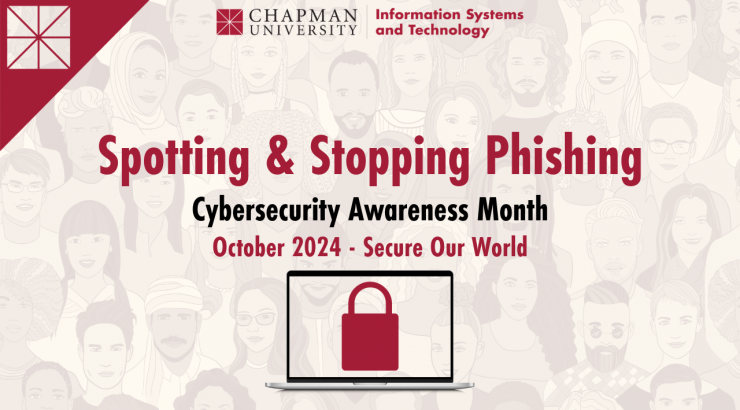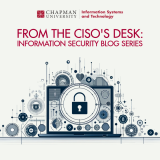
Spotting and Stopping Phishing on Campus
October 11, 2024
Phishing is a pervasive threat that requires constant awareness. By staying informed, recognizing the signs of phishing, and promptly reporting suspicious activities, you play a vital role in safeguarding our campus. As members of the Chapman community, we must stay vigilant and proactive in recognizing and reporting these malicious attempts.
Why Recognizing Phishing Matters
Phishing is a type of cyberattack where attackers attempt to trick individuals into providing sensitive information, such as usernames, passwords, and credit card numbers, using Social Engineering techniques. These attacks can lead to identity theft, financial loss, and unauthorized personal and institutional data access.
For our campus, a successful phishing attack can compromise individual information and sensitive academic and administrative data. The consequences can range from disrupted academic activities to severe privacy and security breaches.
How to Recognize Phishing Attempts
Phishing attempts often appear legitimate, making them tricky to spot. Here are some common characteristics to watch out for:
- Suspicious Email Addresses: Check the sender’s email address closely. Phishers often use addresses similar to legitimate ones but with slight variations.
- Urgent or Threatening Language: Be wary of messages that create a sense of urgency or fear, urging you to act quickly to avoid negative consequences.
- Unexpected Attachments or Links: Avoid clicking on links or downloading attachments from unknown or unexpected sources. These could contain malware.
- Requests for Sensitive Information: Legitimate institutions will never ask for passwords, Social Security numbers, or credit card details via email.
- Generic Greetings: Phishing emails often use generic greetings instead of addressing you by name.
Steps to Take if You Suspect a Phishing Attempt
If you encounter a suspicious email or message, follow these steps:
- Do Not Respond or Click Links: Avoid replying to the email, clicking on links, or downloading attachments.
- Verify the Source: Contact the supposed sender directly using a known, trusted method (e.g., an official website or phone number) to verify the email’s authenticity.
- Report the Phishing Attempt: Forward the suspicious email to abuse@chapman.edu.
- Delete the Email: Once reported, delete the phishing email from your inbox and trash folder.
Why Reporting Phishing Matters
Reporting phishing attempts is crucial. It enables IS&T to:
- Investigate and Mitigate Threats: Identify and neutralize phishing threats to protect the campus community.
- Raise Awareness: Educate others about current phishing tactics and how to avoid them.
- Enhance Security Measures: Continuously improve security protocols to defend against evolving cyber threats.
Remember, cybersecurity is a shared responsibility. Let’s stay alert, report phishing attempts, and support each other in maintaining the integrity and security of our campus community. For more information or to report a phishing attempt, visit the Phishing information page. If you need assistance or think your account has been compromised, contact the IS&T Service Desk at servicedesk@chapman.edu.
Stay vigilant and stay protected!
Chapman University Information Systems and Technology (IS&T)

